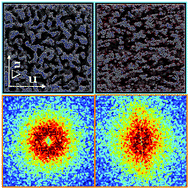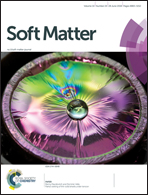Yield of reversible colloidal gels during flow start-up: release from kinetic arrest†
Abstract
Yield of colloidal gels during start-up of shear flow is characterized by an overshoot in shear stress that accompanies changes in network structure. Prior studies of yield of reversible colloidal gels undergoing strong flow model the overshoot as the point at which network rupture permits fluidization. However, yield under weak flow, which is of interest in many biological and industrial fluids shows no such disintegration. The mechanics of reversible gels are influenced by bond strength and durability, where ongoing rupture and re-formation impart aging that deepens kinetic arrest [Zia et al., J. Rheol., 2014, 58, 1121], suggesting that yield be viewed as release from kinetic arrest. To explore this idea, we study reversible colloidal gels during start-up of shear flow via dynamic simulation, connecting rheological yield to detailed measurements of structure, bond dynamics, and potential energy. We find that pre-yield stress grows temporally with the changing roles of microscopic transport processes: early time behavior is set by Brownian diffusion; later, advective displacements permit relative particle motion that stretches bonds and stores energy. Stress accumulates in stretched, oriented bonds until yield, which is a tipping point to energy release, and is passed with a fully intact network, where the loss of very few bonds enables relaxation of many, easing glassy arrest. This is immediately followed by a reversal to growth in potential energy during bulk plastic deformation and condensation into larger particle domains, supporting the view that yield is an activated release from kinetic arrest. The continued condensation of dense domains and shrinkage of network surfaces, along with a decrease in the potential energy, permit the gel to evolve toward more complete phase separation, supporting our view that yield of weakly sheared gels is a ‘non-equilibrium phase transition’. Our findings may be particularly useful for industrial or other coatings, where weak, slow application via shear may lead to phase separation, inhibiting smooth distribution.



 Please wait while we load your content...
Please wait while we load your content...
